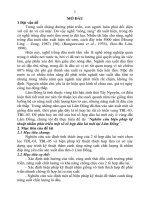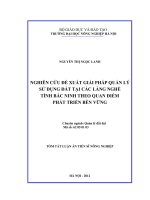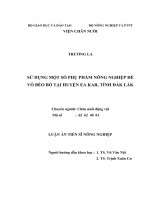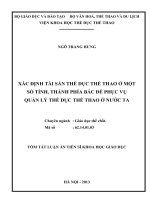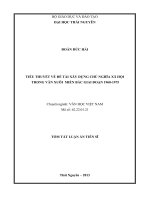Đề tài tiến sĩ Structural Identification
Bạn đang xem bản rút gọn của tài liệu. Xem và tải ngay bản đầy đủ của tài liệu tại đây (59.85 KB, 2 trang )
Structural Identification : Prestressed Concrete Girder Bridges for Strength
Evaluation
Author: Anun Patjawit Year: 2005 Field of Study: Structural Engineering Abstract:
A research study for developing a procedure for monitoring structural condition of bridge
structures, which eventually provides essential information used for bridge rating, has
been conducted. The study has been aimed for achieving a monitoring method that is
relatively simple, convenient for use, economical and less time-consuming, but can yield
reliable results. Impact testing and finite element techniques have been selected as the
principal tools for acquiring dynamic characteristics of the structures to be studied.
After its successful application on idealized structures as structural steel and reinforced
concrete beams in laboratory, impact testing has been conducted on the prestressed
concrete bridge located in the provinces of central Thailand. The critical dynamic
responses of the bridge collected during the testing process were mode shape, natural
frequency and flexibility matrix norm. Next, finite-element analytical model was
developed for the tested bridge and eigenvalue analysis was then performed. Calibration
of input data for the analytical model was also incorporated in the analysis so that the
structural responses comparable to that obtained from the field test were resulted. By
performing truckload testing on the bridge, the developed finite element model was
proved capable of yielding accurate structural responses under static loads as well. The
results from these finite element analyses were then used in bridge rating procedure. The
test bridges appeared to be in good condition according to their rating results.
In addition, the flexibility matrix norm, one of the critical structural parameters
introduced and studied along the way, was found to be the more effective indicator for
monitoring the structural condition of bridge structures compared to mode shape and
natural frequency. This is due to its relatively high sensitivity to structural damage or
deterioration. Therefore, continual monitoring the values of flexibility matrix norm can
provide for bridge engineers the guideline when rigorous bridge inspection shall be
performed.
Chairman: Prof. Worsak Committee: Dr. Barry Prof. Ogunlana
Component-based Information-oriented Framework for Integrated Structural
Applications
Author: Naveed Anwar Year: 2004 Field of Study: Structural Engineering Abstract:
The mechanical and electronics industries have long embraced the idea of component-
based manufacturing of their products. Similarly, component-based software development
has gained wide acceptance within the computer science discipline and the software
development industry. Component-based software development is a logical extension of
object-oriented concepts and the corresponding object technologies, which have pervaded
in the software industry since the early 1990s. No formal attempt has been made,
however, to use component-based architecture for development of structural engineering
applications, although several applications of object-oriented techniques have been
explored and reported in literature.
The impact of Information Technology and the Internet on almost all disciplines and
computer applications is significantly changing the traditional concepts of data processing
and data orientation. The overall structural design process can also be viewed as an
information transformation process; hence the development of integrated applications
using information orientation. Information in the computing environment is being
represented and communicated increasingly through markup languages, most notably
Extensible Markup Language (XML). No significant efforts have been made in the
structural engineering discipline to represent the design information in standard markup
languages to make it universally accessible and understandable.
This research presents the overall framework for component-based software development
for integrated structural engineering applications using the principles of information
transformation. Once the components have been developed within this framework,
specific applications can be developed by assembling them. An information-oriented
review of the overall structural design process is carried out to develop the information
content and transformations involved in this process. This information transformation
concept is then used to propose a framework for the development of software for
integrated structural design applications including the identification of key packages,
patterns, components, class hierarchies and object models. Use of XML is proposed as the
main information description and communication standard. The advantages of using the
proposed framework are discussed along with application and implementation scenarios.
Chairman: Prof. Worsak Kanok-Nukulchai Committee: Dr. Dentcho N. Batanov, Dr.
Pennung Warnitchai, Dr. Kim Kidu External Committee: Prof. Edward L. Wilson


